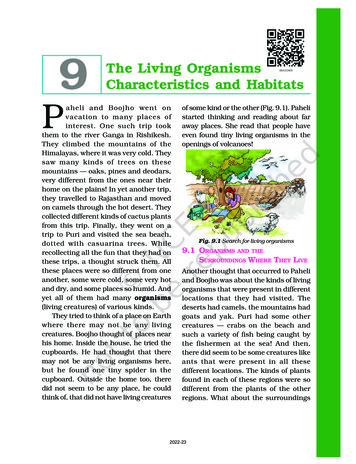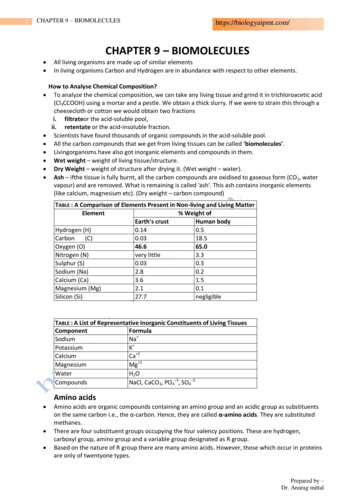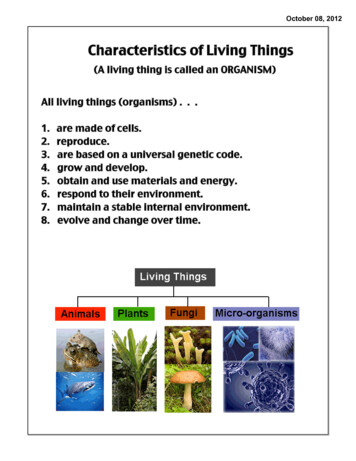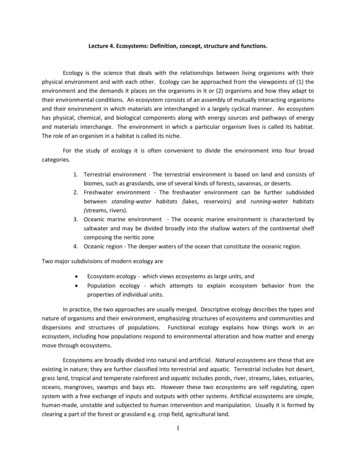
Transcription
9PThe Living Organisms —Characteristics and Habitatsaheli and Boojho went onvacation to many places ofinterest. One such trip tookthem to the river Ganga in Rishikesh.They climbed the mountains of theHimalayas, where it was very cold. Theysaw many kinds of trees on thesemountains — oaks, pines and deodars,very different from the ones near theirhome on the plains! In yet another trip,they travelled to Rajasthan and movedon camels through the hot desert. Theycollected different kinds of cactus plantsfrom this trip. Finally, they went on atrip to Puri and visited the sea beach,dotted with casuarina trees. Whilerecollecting all the fun that they had onthese trips, a thought struck them. Allthese places were so different from oneanother, some were cold, some very hotand dry, and some places so humid. Andyet all of them had many organisms(living creatures) of various kinds.They tried to think of a place on Earthwhere there may not be any livingcreatures. Boojho thought of places nearhis home. Inside the house, he tried thecupboards. He had thought that theremay not be any living organisms here,but he found one tiny spider in thecupboard. Outside the home too, theredid not seem to be any place, he couldthink of, that did not have living creaturesof some kind or the other (Fig. 9.1). Pahelistarted thinking and reading about faraway places. She read that people haveeven found tiny living organisms in theopenings of volcanoes!Fig. 9.1 Search for living organisms9.1 ORGANISMS AND THESURROUNDINGS WHERE THEY LIVEAnother thought that occurred to Paheliand Boojho was about the kinds of livingorganisms that were present in differentlocations that they had visited. Thedeserts had camels, the mountains hadgoats and yak. Puri had some othercreatures — crabs on the beach andsuch a variety of fish being caught bythe fishermen at the sea! And then,there did seem to be some creatures likeants that were present in all thesedifferent locations. The kinds of plantsfound in each of these regions were sodifferent from the plants of the otherregions. What about the surroundings2022-23
in these different regions? Were theythe same?will discuss the table as we travelthrough many more interesting places.Activity 19.2 HABITAT AND ADAPTATIONLet us start with a forest. Think of allthe plants, animals and objects that canbe found there. List them in Column 1of Table 9.1. List things, animals andplants, found in the other regions thatare also shown in the table. You cancollect the examples scattered throughthis chapter to fill Table 9.1. Discussalso with your friends, parents andteachers, to find more examples to fillthe tables. You can also consult manyinteresting books in libraries that talkof animals, plants and minerals ofdifferent regions.T ry and include many plants,animals and objects, big and small, ineach of the columns in this table. Whatkind of objects will we find that may notbe animals or plants? Perhaps parts ofplants like dried leaves, or parts ofanimals, like bones. We may also finddifferent kinds of soils and pebbles.Water in the oceans may have saltsdissolved in it as discussed in Chapter5. There could be many more objects.As we go through the chapter, keepadding more examples to Table 9.1. WeWhat do you find from the plants andanimals listed in Activity 1? Did you finda large variety in them? Look at what youhave entered in the column for the desertand the column for the sea in Table 9.1.Did you list very different kind oforganisms in these two columns?What are the surroundings like, inthese two regions?In the sea, plants and animals aresurrounded by saline (salty) water. Mostof them use the air dissolved in water.There is very little water available inthe desert. It is very hot in the day timeand very cold at night in the desert. Theanimals and plants of the desert live onthe desert soil and breathe air from thesurroundings.The sea and the desert are verydifferent surroundings and we find verydifferent kind of plants and animals inthese two regions, isn’t it? Let us lookat two very different kind of organismsfrom the desert and the sea – a cameland a fish. The body structure of a camelhelps it to survive in desert conditions.Camels have long legs which help toTable 9.1 Animals, plants and other objects found in different surroundingsIn the forestOn mountainsIn the desert80In the seaAny other?SCIENCE2022-23
keep their bodies away from the heat ofthe sand (Fig. 9.2). They excrete smallamount of urine, their dung is dry andthey do not sweat. Since camels losevery little water from their bodies, theycan live for many days without water.Let us look at different kinds of fish.Some of these are shown in Fig. 9.3.There are so many kinds of fish, but, doyou see that they all have somethingcommon about their shape? All the onesshown here have the streamlined shapethat was discussed in Chapter 8. Thisshape helps them move inside water.Fish have slippery scales on their bodies.These scales protect the fish and alsohelp in easy movement through water.We discussed in Chapter 8, that fishhave flat fins and tails that help themto change directions and keep their bodybalance in water. Gills present in thefish help them to use oxygen dissolvedin water.We see that the features of a fish helpit to live inside water and the features ofa camel help it to survive in a desert.We have taken only two examplesfrom a very wide variety of animals andplants that live on the Earth. In all thisvariety of organisms, we will find thatthey have certain features that helpthem live in the surroundings in whichthey are normally found. The presenceof specific features or certain habits,which enable an organism to livenaturally in a place is called adaptation.Adaptation of organisms differdepending on their place of dwelling.That is why a fish cannot live out ofwater and a camel cannot live in sea.The place where organisms live iscalled habitat. Habitat means a dwellingplace (a home). The habitat providesfood, water, air, shelter and other needsto organisms. Several kinds of plantsand animals live in the same habitat.The plants and animals that live onland are said to live in terrestrialhabitats. Some examples of terrestrialhabitats are forests, grasslands, deserts,coastal and mountain regions. On theother hand, the habitats of plants andFig. 9.2 Camels in their surroundingsFig. 9.3 Different kinds of fishTHE LIVING ORGANISMS — CHARACTERISTICS AND HABITATS2022-2381
There are some changes that can happen in an organism over a short period oftime to help them adjust to some changes in their surroundings. For instance,if we live in the plains and suddenly go to high mountain regions, we mayexperience difficulty in breathing and doing physical exercise for some days.We need to breathe faster when we are on high mountains. After some days,our body adjusts to the changed conditions on the high mountain. Such smallchanges that take place in the body of a single organism over short periods, toovercome small problems due to changes in the surroundings, are calledacclimatisation. These changes are different from the adaptations that takeplace over thousands of years.animals that live in water are calledaquatic habitats. Lakes, rivers andoceans are some examples of aquatichabitats. There are large variationsamong terrestrial habitats like forests,grasslands, deserts, coastal andmountain regions located in differentparts of the world.The organisms, both plants andanimals, living in a habitat are its bioticcomponents. The non-living things suchas rocks, soil, air and water inthe habitat constitute its abioticcomponents. Are sunlight and heatbiotic or abiotic components?We know that some plants grow fromseeds. Let us look at some abiotic factorsand their effect on seeds as they growinto young plants.Activity 2Recall Activity 5 in Chapter 1 — we madesprouts from moong and chana seeds.When the seed turned into a sprout, itis said to have germinated. This is thebeginning of life of a new plant.Collect some dry moong seeds. Keep20-30 seeds aside and soak the rest inwater for a day. Divide the soaked seedsinto four parts. Keep one partcompletely submerged in water for 3-4days. Do not disturb the dry seeds andthose submerged in water. Keep one partof soaked seeds in a sunny room andanother in a completely darkregion like a cupboard that does notallow any light to come in. Keep the lastpart in very cold surroundings, say, ina refrigerator or with ice around them.Rinse them and replace the water everyday. What do you notice, after a fewdays? Do the seeds in all the fiveconditions germinate uniformly? Do youfind slower or no germination in any ofthese?Do you realise that abiotic factors likeair, water, light and heat are importantfor the growth of plants. In fact, abioticfactors are important for all livingorganisms.We find that organisms exist in verycold as well as very hot climates, isn’tit? How do they manage to survive?Adaptation is the method by whichorganisms get well adjusted to theclimate.82SCIENCE2022-23
Adaptation does not take place in ashort time because the abiotic factors ofa region also change very slowly. Thoseorganisms which cannot adapt to thesechanges die, and only the adapted onessurvive. Organisms adapt to differentabiotic factors in different ways. Thisresults in a wide variety of organisms indifferent habitats.Let us look at some habitats,understood the abiotic factors and theadaptations of animals in these habitats.Fig. 9.4 Desert animals in burrows9.3 A JOURNEY THROUGH DIFFERENTHABITATSSome Terrestrial HabitatsDesertsWe discussed the abiotic factors of adesert and the adaptations in camels.What about other animals and plantsthat are found in deserts? Do theyhave the same kind of adaptations?There are desert animals like ratsand snakes, which do not have long legsthat a camel has. To stay away from theintense heat during the day, they stayin burrows deep in the sand (Fig 9.4).These animals come out only during thenight, when it is cooler.Fig. 9.5 shows some typical plantsthat grow in a desert. How are theseadapted to the desert?Activity 3Bring a potted cactus and a leafy plantto the classroom. Tie polythene bags tosome parts of the two plants, as wasdone for Activity 4 in Chapter 7, wherewe studied transpiration in plants.Fig. 9.5 Some typical plants that grow in desertLeave the potted plants in the sun andobserve after a few hours. What do yousee? Do you notice any difference in theamount of water collected in the twopolythene bags?Desert plants lose very little waterthrough transpiration. The leaves indesert plants are either absent, verysmall, or they are in the form of spines.This helps in reducing loss of water fromthe leaves through transpiration. Theleaf-like structure you see in a cactusis, in fact, its stem (Fig. 9.5).Photosynthesis in these plants isusually carried out by the stems. TheTHE LIVING ORGANISMS — CHARACTERISTICS AND HABITATS2022-2383
stem is also covered with a thick waxylayer, which helps to retain water in thetissues of cacti. Most desert plants haveroots that go very deep into the soil forabsorbing water.Mountain regionsThese habitats are normally very coldand windy. In some areas, snowfall maytake place in winters.There is a large variety of plants andanimals living in the mountain regions.Have you seen the kind of trees shownin Fig. 9.6?also present on mountains. They mayhave different kind of adaptations tosurvive on the mountains.Animals living in the mountain regionsare also adapted to the conditions there(Fig. 9.7). They have thick skin or fur toprotect them from cold. For example, yakshave long hair to keep them warm. Snowleopard has thick fur on its body(a)Fig. 9.6 Trees of a mountain habitatIf you live in a mountain region orhave visited one, you may have seen alarge number of such trees. But, haveyou ever noticed such trees naturallygrowing in other regions?How are these trees adapted to theconditions prevailing in their habitat?These trees are normally cone shapedand have sloping branches. The leavesof some of these trees are needle-like.This helps the rainwater and snow toslide off easily. There could be trees withshapes very different from these that are(b)Fig. 9.7 (a) Snowleopard, (b) yakand (c) mountaingoat are adapted tomountain habitats84(c)SCIENCE2022-23
including feet and toes. This protects itsfeet from the cold when it walks on thesnow. The mountain goat has stronghooves for running up the rocky slopesof the mountains.As we go up in the mountainousregions, the surroundings change andwe see different kinds of adaptations atdifferent heights.GrasslandsA lion lives in a forest or a grasslandand is a strong animal that can huntand kill animals like deer. It is lightbrown in colour. Look at the picture ofa lion and that of a deer (Fig. 9.8). Howare the eyes placed in the face for thesetwo animals? Are they in the front oron the side of the face? Lions have longclaws in their front legs that can bewithdrawn inside the toes. Do thefeatures of a lion help it in any way tosurvive? It’s light brown colour helps itto hide in dry grasslands when it huntsfor prey (animals to eat). The eyes infront of the face allow it to have a correctidea about the location of its prey.A deer is another animal that lives inforests and grasslands. It has strong teethfor chewing hard plant stems of theforest. A deer needs to know about thepresence of predators ( animals like lionthat make it their prey ) in order to runaway from them and not become theirprey. It has long ears to hear movementsof predators. The eyes on the side of itshead allow it to look in all directions fordanger. The speed of the deer helps themto run away from the predators.There are many other features of alion, a deer or other animals and plantsthat help them to survive in theirhabitat.Some Aquatic HabitatsOceansWe already discussed how fish areadapted to live in the sea. Many othersea animals have streamlined bodies tohelp them move easily in water. Thereare some sea animals like squids andoctopus, which do not have thisstreamlined shape. They stay deeper inthe ocean, near the seabed and catchany prey that moves towards them.However, when they move in water theymake their body shapes streamlined.These animals have gills to help themuse oxygen dissolved in water.There are some sea animals likedolphins and whales that do not have(a)(b)Fig. 9.8 (a) Lion and (b) deerTHE LIVING ORGANISMS — CHARACTERISTICS AND HABITATS2022-2385
gills. They breathe in air throughnostrils or blowholes that are locatedon the upper parts of their heads. Thisallows them to breathe in air when theyswim near the surface of water. They canstay inside the water for a long timewithout breathing. They come out to thesurface from time to time, to breathe inair. Did you ever see this interestingactivity of dolphins in televisionprogramme or films on ocean life?Ponds and lakesHave you seen plants growing in ponds,lakes, rivers and even some drains? Goon a field trip to a nearby pond, if possible,and try to observe the kinds of plants thatare seen there. Observe the leaves, stemsand roots of these plants.Some of these plants have their rootsfixed in the soil below the waterFig. 9.9 Some aquatic plants float on water.Some have their roots fixed in the soil at thebottom. Some aquatic plants aresubmerged in water.(Fig. 9.9). In terrestrial plants, rootsnormally play a very important role in theabsorption of nutrients and water fromthe soil. However, in aquatic plants, rootsare much reduced in size and their mainfunction is to hold the plant in place.The stems of these plants are long,hollow and light. The stems grow up tothe surface of water while the leaves andflowers, float on the surface of water.Some aquatic plants are submergedin water. All parts of such plants areunder water. Some of these plants havenarrow and thin ribbon-like leaves.These can bend in the flowing water. Insome submerged plants, leaves are oftenhighly divided, through which the watercan easily flow without damaging them.Frogs usually live in ponds. Frogscan stay both inside the water as wellas move on land. They have strong backlegs that help them in leaping andcatching their prey. They have webbedfeet which help them swim in water.We have discussed only a few commonanimals and plants compared to the widevariety that live in different habitats. Youmay have also noticed the very widevariety in plants around you, when youprepared a herbarium as part of thesuggested activities in Chapter 7.Imagine the kind of variety that youcould see in a herbarium of leaves ofplants from all regions of the Earth!9.4 CHARACTERISTICSOFORGANISMSWe went on a journey through differenthabitats and discussed many plants and86SCIENCE2022-23
animals. In Activity 1, we listed objects,plants and animals found in differentsurroundings. Suppose we stop a whileand think which examples in our listare living? Let us think of examples froma forest. Trees, creepers, small and biganimals, birds, snakes, insects, rocks,soil, water, air, dry leaves, dead animals,mushrooms and moss may be only someof the objects that are present in theforest. Which of these are living?Think of objects that you can seearound you at this moment and groupthem as living and non-living. In somecases, it is easy for us to know. Forexample, we know that objects like chairor table are not alive. Paheli was readingthis rhyme from Complete Nonsensewritten by Edward Lear:Chair,ble to theaTethidSaware,ardly be a’You can he heat,ther fromffust!Iwo’Hon my feechilblainsmofrdn’Alk,a little wa’If we tookle talk!ttlihave athigme’Wair!’s take the’Pray let uChair.ethable toTethidaSe table,hair to thCe!thidaSre not ableknow we auoywo’Nlk,shly you talk!’’How foolicannot waewknowuoyne,hh’Wa sigable withSaid the Ttry,tono harmodnact’Iyou,ny legs asamsae’v’In two?’we walk o’tnacyh’WPaheli and Boojho found the poemvery funny, because they knew that achair or a table is not alive and it cannottalk or walk.Chair, table, stone or a coin are notalive. Similarly, we do know that we arealive and so are all the people of theworld. We also see animals around usthat are so full of life — dogs, cats,monkeys, squirrels, insects and manyothers.How do we know that something isliving? Often, it is not so easy to decide.We are told that plants are living, butthey do not move like a dog or a pigeon.On the other hand, a car or a bus canmove, still we consider them as nonliving. Plants and animals appear togrow in size with time. But then, attimes, clouds in the sky also seem togrow in size. Does it mean that cloudsare living? No! So, how does onedistinguish between living and nonliving things? Do living things havesome common characteristics thatmake them very different from thenon-living?You are a wonderful example of a livingbeing. What characteristics do you havewhich make you different from a nonliving thing? List a few of thesecharacteristics in your notebook. Look atyour list and mark those characteristicsthat you have listed, which may also befound in animals or plants.Some of these characteristics areperhaps common to all living things.THE LIVING ORGANISMS — CHARACTERISTICS AND HABITATS2022-2387
Do all organisms need food?In Chapters 1 and 2, we learnt that allliving things need food and howessential it is to animals and to us. Wehave also learnt that plants make theirown food by the process ofphotosynthesis. Animals depend onplants or other animals for their food.Food gives organisms the energyneeded for them to grow. Organisms alsoneed energy for other life processes thatgo on inside them.Do all organisms showgrowth?Does the kurta you had four years back,still fit you? You cannot wear it anymore, isn’t it? You must have growntaller during these years. You may notrealise it, but you are growing all thetime and in few more years you willbecome an adult. (Fig 9.10).Young ones of animals also growinto adults. You would surely haveFig. 9.10 A baby grows into an adultnoticed pups growinto adults. A chickhatched from anegg, grows intoa hen or a cock.(Fig 9.11).Plants also grow.Look around youand see a few plantsof a particular type.Some are very smallFig. 9.11 A chickenand young, some grows into an adultare bigger. Theymay all be in different stages of growth.Look at the plants after a few days andweeks. You may find that some of themhave grown in size. Growth seems to becommon to all living things.Do you think, non-living things showgrowth?Do all organisms respire?Can we live without breathing? Whenwe inhale, the air moves from outside tothe inside of our body. When we breatheout, the air moves from inside our bodyto outside. Breathing is part of a processcalled respiration. In respiration, someof the oxygen of the air we breathe in, isused by the body. We breathe out carbondioxide produced in this process.The process of breathing in animalslike cows, buffaloes, dogs or cats issimilar to humans. Observe any one ofthese animals while they are taking rest,and notice the movement of theirabdomen. This slow movement indicatesthat they are breathing.88SCIENCE2022-23
Respiration is necessary for all livingorganisms. It is through respiration thatthe body finally obtains energy from thefood it takes.Some animals may have differentmechanisms for the exchange of gases,which is a part of the respiration process.For example, earthworms breathethrough their skin. Fish, we have learnt,have gills for using oxygen dissolved inwater. The gills absorb oxygen from theair dissolved in water.Do plants also respire? Exchange ofgases in plants mainly takes placethrough leaves. The leaves take in airthrough tiny pores in them and use theoxygen. They give out carbon dioxide tothe air.We learnt that in sunlight, plantsuse carbon dioxide to produce food andgive out oxygen. The amount of oxygenreleased in the process of foodpreparation by plants is much morethan the oxygen they use in respiration.Respiration in plants takes place dayand night.Do all organisms respond tostimuli?How do you respond, if you suddenlystep on a sharp object like a thorn, whilewalking barefoot? How do you feel whenyou see or think about your favouritefood? You suddenly move from a darkplace into bright sunlight. Whathappens? Your eyes shut themselvesautomatically for a moment tillthey adjust to the changed brightsurroundings. Your favourite food,bright light and a thorn, in the abovesituations are some examples of changesin your surroundings. All of us respondimmediately to such changes. Changesin our surroundings that makes usrespond to them, are called stimuli.Do other animals also respond tostimuli? Observe the behaviour ofanimals, when food is served to them.Do you find them suddenly becomingactive on seeing the food? When youmove towards a bird, what does it do?Wild animals run away when brightlight is flashed towards them. Similarly,cockroaches begin to move to theirhiding places if the light in the kitchenis switched on at night. Can you givesome more examples of responses ofanimals to stimuli?Do plants also respond to stimuli?Flowers of some plants bloom only atnight. In some plants flowers close aftersunset. In some plants like Mimosa,commonly known as ‘touch-me-not’,leaves close or fold when someonetouches them. These are some examplesof responses of plants towards changesin their surroundings.Activity 4Place a potted plant in a room a littleaway from a window through whichsunlight enters some time during theday (Fig. 9.12). Continue watering theplant for a few days. Does the plant growupright, like plants out in the open?Note the direction in which it bends, ifTHE LIVING ORGANISMS — CHARACTERISTICS AND HABITATS2022-2389
Do all organismsreproduce their ownkind?Have you ever seen nests ofsome birds like pigeons?Many birds lay their eggs inthe nest. Some of the eggs hatch andyoung birds come out of them(Fig. 9.13).Fig. 9.12 Plant respond to lightit is not growing upright. Do you think,this may be in response to somestimulus?All living things respond to changesaround them.Living organisms and excretionAll organisms need food. Not all thefood that is eaten is completely used,only a part of it is utilised by the body.What happens to the rest? This has tobe removed from the body as wastes. Ourbody produces some wastes in other lifeprocesses also. The process of gettingrid of wastes by organisms is known asexcretion.Do plants also excrete? They do, butnot as seen in animals. The mechanismsin plants are a little different. Some plantsfind it possible to store the waste productswithin their parts in a way that they donot harm the plant as a whole. Someplants remove waste products assecretions.Excretion is another characteristiccommon to all organisms.(b)(a)Fig. 9.13 (a) Birds lay eggs which after hatchingproduce (b) young onesAnimals reproduce their own kind.The mode of reproduction may bedifferent, in different animals. Someanimals produce their young onesthrough eggs. Some animals give birthto the young ones (Fig. 9.14).Plants also reproduce. Like animals,plants also differ in their mode ofreproduction. Many plants reproducethrough seeds. Plants produce seeds,90Fig. 9.14 Some animals which give birth totheir young onesSCIENCE2022-23
Living things produce more of theirown kind through reproduction. Ittakes place in many different ways, fordifferent organisms.Do all organisms move?Fig. 9.15 A seed from a plant germinates into anew plantwhich can germinate and grow into newplants (Fig.9.15).Some plants also reproduce throughparts other than seeds. For example, apart of a potato with a bud, grows into anew plant (Fig 9.16).Fig. 9.16 A new plant grows from a bud of potatoPlants also reproduce throughcuttings. Would you like to grow a plantin this way yourself?Activity 5Take a cutting from a rose or a menhdiplant. Fix it in the soil and water itregularly. What do you observe, after afew days?It may not be easy to grow plants fromcuttings. Do not be disappointed if yourcutting does not grow. Talk to a gardener,if possible, on the care to be given tocuttings to make them grow into plants.In Chapter 8, we discussed the variousways in which animals move. They movefrom one place to another and also showother body movements.What about plants? Do they alsomove? Plants are generally anchored insoil so they do not move from one placeto another. However, various substanceslike water, minerals and the foodsynthesised by them move from one partof the plant to other. Have you noticedany other kind of movement in plants?Opening or closing of flowers? Do yourecall how some plants show movementin response to certain stimuli?We also have some non-livingthings moving, of course. A bus, car, asmall piece of paper, clouds and so on.Is there something different in thesemovements from the movements ofliving beings?There is such a variety of livingorganisms, but, all of them show somecommon characteristics, as we havediscussed. Yet another commoncharacteristic is that living beings die.Because organisms die, particular typesof organisms can survive over thousandsof years only if they reproduce their ownkind. One single organism maydie without ever reproducing, but, thetype of organism can exist only if thereis reproduction.THE LIVING ORGANISMS — CHARACTERISTICS AND HABITATS2022-2391
We see that, all living things seem tohave some common characteristics.They all need food, respire, respond tostimuli, reproduce, show movement,grow and die.Do we find some non-living things thatalso show some of these characteristics?Cars, bicycle, clocks and the water inthe river move. The moon moves in thesky. A cloud grows in size right in frontof our eyes. Can such things be calledliving? We ask ourselves, do these objectsalso show all the other characteristicsof living things?In general, something that is livingmay have all the characteristics that wehave discussed, while non-living thingsmay not show all these characteristicsat the same time.Is this always true? Do we always findthat living things definitely show all thecharacteristics of the living that we havediscussed? Do we always find that nonliving things may show only some of thesecharacteristics and never all of them?To understand this a little better, letus look at a specific example. Considerany seed, say, moong. Is it living? It canstay in a shop for months and not showany growth or some of the othercharacteristics of life. However, we bringthe same seed and plant it in soil, waterit and it turns into a whole plant. Didthe seed — need food, did it excrete,grow or reproduce when it was in theshop for many months?We see that there can be cases whenwe cannot easily say that a thing has allthe characteristics that we have discussed,for it to be called living.“What then is life?”Push your hand deep inside a sack ofwheat. Do you find it is warm inside?There is some heat being producedinside the sack of wheat. The seedsrespire and in that process give outsome heat.We see that respiration is a processthat takes place in seeds even whensome of the other life processes may notbe very active.It may not be very easy to answerour question — “what then is life”?However, looking at all the diversity ofliving beings around us, we canconclude that “life is beautiful”!AdaptationHabitatAquatic habitatLivingBiotic mulus92SCIENCE2022-23
nThe surroundings where plants and animals live, is called their habitat.nSeveral kinds of plants and animals may share the same habitat.nThe presence of specific features and habits, which enable a plant or ananimal to live in a particular habitat, is called adaptation.nThere are many types of habitats, however, these may be broadly groupedas terrestrial (on the land) and aquatic (in water).nThere is a wide variety of organisms present in different habitats.nPlants, animals and microorganisms together constitute bioticcomponents.nRocks, soil, air, water, light and temperature are some of the abioticcomponents of our surroundings.nLiving things
oceans are some examples of aquatic habitats. There are large variations among terrestrial habitats like forests, grasslands, deserts, coastal and mountain regions located in different parts of the world. The organisms, both plants and animals, living in a habitat are its biotic component










